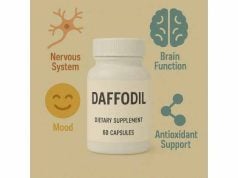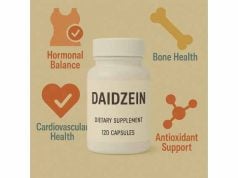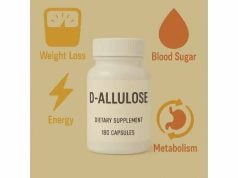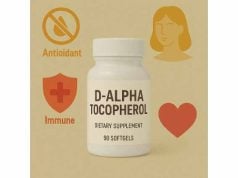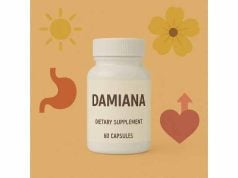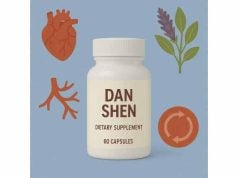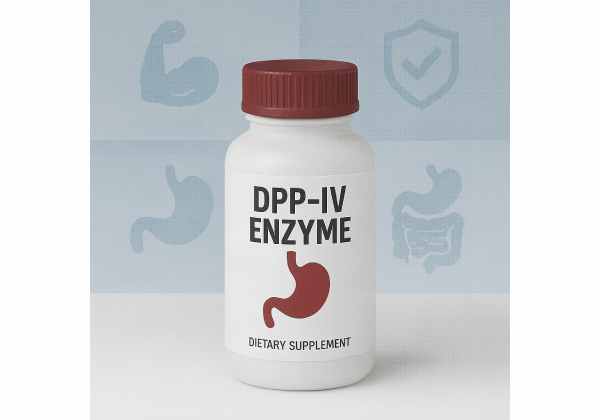
Dipeptidyl peptidase-4 (DPP-IV, also called DPP-4 or CD26) is an enzyme your body makes that clips tiny pieces off certain peptides, including hormones that regulate blood sugar and many immune-signaling molecules. In nutrition and wellness, “DPP-IV” also appears on digestive enzyme labels—usually to suggest help with hard-to-digest proteins such as gluten or casein. This article separates what the human enzyme does from what DPP-IV-labeled supplements can and cannot do. You will learn where DPP-IV matters (glucose control, immunity, protein digestion), how to choose and use an enzyme product intelligently, what realistic benefits to expect, how to approach dosage, and when to avoid it. We will also flag the confusing overlap with prescription DPP-4 inhibitors used in type 2 diabetes so you can navigate the topic with confidence.
Essential Insights for DPP-IV Enzyme Users
- Supports digestion of proline-rich peptides; limited evidence for symptom relief around hidden gluten exposure.
- Not a treatment for celiac disease; strict gluten avoidance remains essential.
- Typical trial-tested enzyme for gluten, AN-PEP, used 650 mg with each meal (3 times daily).
- Avoid if you have celiac disease and are tempted to “use enzymes instead of a gluten-free diet.”
- Discuss use if you take diabetes medications; supplements are not the same as prescription DPP-4 inhibitors.
Table of Contents
- What is DPP-IV and how it works
- Benefits and uses: what to expect
- Choosing and using DPP-IV supplements
- Dosage: what amounts are used
- Safety, risks, and who should avoid
- Research snapshot: what the evidence says
What is DPP-IV and how it works
Dipeptidyl peptidase-4 (DPP-IV) is a protease—an enzyme that cuts proteins—anchored on many cell surfaces and also present in soluble form in blood. Its specialty is trimming two-amino-acid fragments from the beginning (N-terminus) of peptides when the second amino acid is proline or alanine. That may sound niche, but it has big physiological consequences. DPP-IV rapidly breaks down the incretin hormones GLP-1 and GIP, which help the pancreas release insulin after you eat. Because of this, pharmaceutical DPP-4 inhibitors (“gliptins”) raise GLP-1 and GIP levels to improve blood glucose control in type 2 diabetes. The same enzyme also processes dozens of immunologically active peptides (chemokines and neuropeptides), linking it to T-cell activation and broader immune regulation.
The name “CD26” refers to the molecule’s identity as a T-cell surface antigen. On immune cells, CD26/DPP-4 influences how strongly T cells become activated and how they migrate to tissues, by both enzymatic actions (cutting chemokines) and non-enzymatic interactions (binding to proteins such as adenosine deaminase). In practical terms, that means DPP-IV sits at the crossroads of metabolism and immunity. Levels of soluble DPP-IV in blood can rise or fall with various conditions, and lab studies show that blocking the enzyme can dampen certain inflammatory pathways, although clinical results depend on context.
In nutrition, “DPP-IV enzyme” also appears on digestive enzyme blends. Those products contain a DPP-IV-like activity—often sourced from microbes such as Aspergillus species—to help break down proline-rich segments of dietary proteins. Gluten and casein contain many proline residues, which resist common human proteases, so the idea is that a proline-specific enzyme taken with meals may reduce residual peptides before they reach the small intestine.
Here is where precise biology matters. The DPP-IV activity found in many digestive formulas is an exopeptidase: it nibbles off dipeptides from an exposed N-terminus. It does not slice within long peptides (that is the job of endopeptidases like AN-PEP). In the acidic stomach, many DPP-IV enzymes lose activity, while certain endopeptidases remain active. This difference explains why some supplements advertise both “DPP-IV activity” and “prolyl endopeptidase” together—to combine enzyme actions for better coverage across pH conditions and peptide sizes.
Understanding these roles clarifies the landscape: endogenous DPP-IV is essential for incretin turnover and immune signaling; prescription DPP-4 inhibitors target that enzyme systemically; digestive supplement “DPP-IV” provides local proteolysis in the gut and is not the same as taking a DPP-4 inhibitor. Each context carries different benefits and boundaries, which we explore below.
Benefits and uses: what to expect
Digestive support for proline-rich proteins. Many users take DPP-IV-containing enzyme blends hoping to reduce reactions to “hidden” gluten or to support digestion of dairy proteins. Mechanistically, an exopeptidase that removes X-Pro–starting dipeptides can help shorten certain peptides generated during digestion and may complement other proteases. However, because DPP-IV acts only at peptide ends, it cannot, by itself, fully neutralize large immunogenic gluten fragments. That is why some better-studied products rely on AN-PEP (Aspergillus niger prolyl endopeptidase)—an endopeptidase that works in acidic conditions and attacks internal proline sites—to accelerate gluten breakdown in the stomach.
Realistic expectations for gluten and celiac disease. If you have celiac disease, strict gluten avoidance is still the only proven therapy. Enzymes—DPP-IV, AN-PEP, or combinations—do not replace a gluten-free diet. Clinical research with AN-PEP has shown mixed outcomes: in “challenge” settings it can lower gluten-immunogenic peptides in the stomach and may reduce severe symptoms in some real-life users on a gluten-free diet, but it has not consistently changed serology or mucosal injury. These results support adjunct use for accidental traces, not intentional gluten consumption. For non-celiac gluten sensitivity, symptoms and triggers vary; enzyme use remains investigational.
Everyday digestive comfort. Outside gluten-specific goals, DPP-IV activity can be part of a broader multi-enzyme blend that supports general protein digestion. People sometimes report less post-meal heaviness, particularly with protein-dense or mixed meals. This is plausible: adding targeted proteases can reduce the pool of long peptides that linger in the stomach, though subjective relief depends on overall formula design (combinations of proteases, amylases, lipases) and meal composition.
Not a blood sugar supplement. Because oral digestive enzymes act locally in the gut and are themselves proteins, they are broken down and are not expected to reach the bloodstream in active form. They are not equivalent to prescription DPP-4 inhibitors and should not be used to treat diabetes or to modify your medication plan. If you are on a DPP-4 inhibitor (sitagliptin, linagliptin, alogliptin, saxagliptin, or others), enzyme supplements should not substitute for therapy, and you should discuss any supplement changes with your clinician.
Who might consider a DPP-IV-containing enzyme.
- People on a gluten-free diet who want a layer of protection against hidden traces (e.g., restaurant cross-contact) and understand enzymes are adjuncts, not permission to eat gluten.
- Those who experience post-meal heaviness with protein-rich meals and want a multi-enzyme approach that includes proline-targeted activity.
- Individuals experimenting with digestive enzyme support under guidance to see if symptoms (e.g., after certain dairy or wheat-containing meals) improve.
Who should not rely on it.
- Anyone with celiac disease or wheat allergy who is considering enzymes as a substitute for strict avoidance.
- People seeking to control blood sugar—this is not an antidiabetic therapy.
Take-home point: the most evidence for reducing gluten-immunogenic peptides comes from an endopeptidase (AN-PEP) used with meals; DPP-IV activity alone is insufficient in the stomach environment. For general digestive support, DPP-IV can be part of a thoughtful blend but manage expectations accordingly.
Choosing and using DPP-IV supplements
1) Read the label beyond the buzzword. Look for a “Supplement Facts” panel that lists enzyme activities, not just milligrams. For DPP-IV, reputable labels declare activity in DPP-IV units (often abbreviated as DPPIVU), defined by how fast the enzyme liberates p-nitroaniline from a standard substrate (Gly-Pro-pNA) under testing conditions. Activity units tell you functional strength far better than milligram weight, which doesn’t indicate potency.
2) Prefer formulas that pair exopeptidase with endopeptidase. If your goal is to minimize residual gluten peptides, a product that includes prolyl endopeptidase (often listed as AN-PEP) alongside DPP-IV activity is mechanistically stronger. DPP-IV trims from peptide ends; AN-PEP cuts inside long, proline-rich regions. Together they can shorten peptides more completely across meal pH ranges.
3) Time it right. Enzymes work on the food in your stomach. For best effect, take them with the first bite or right before eating. If you forget and take them at the end, the window for stomach action may be smaller, especially for acid-sensitive enzymes.
4) Match dose to meal size and your goal. Bigger, protein-heavy meals present more substrate; smaller meals need less. Many users start with the lowest label dose per meal and increase to the maximum suggested if no effect is noticed after several trials. For gluten adjunct use, products modeled on clinical protocols with AN-PEP typically recommend one serving with each main meal.
5) Set a realistic endpoint. Approach enzymes as a 2–4 week trial. Keep a simple symptom log: meal type, timing, dose, symptoms (bloating, heaviness, urgency), and any exposures when dining out. If the pattern doesn’t improve, reconsider the formula—or whether enzymes are the right lever for your symptoms.
6) Keep celiac disease non-negotiables. Even with an AN-PEP-containing product, a strict gluten-free diet is the foundation. In trials, AN-PEP did not consistently reduce biomarkers of immune activation or reverse intestinal damage. Enzymes may modestly lower symptom severity for some, but they do not erase risk from gluten exposure.
7) Think holistically. If dairy regularly bothers you, an enzyme that also supplies lactase could be more relevant than DPP-IV per se. For high-fat meals, include lipase; for beans and brassicas, alpha-galactosidase may help. Multi-enzyme blends are often more practical than single-enzyme products.
8) Quality and sourcing. Most supplemental DPP-IV and prolyl endopeptidases are produced by Aspergillus species. If you have allergies to molds or fermentation-derived ingredients, consult your clinician and consider a cautious trial. Choose brands that disclose activity units, provide third-party testing, and avoid unnecessary additives.
9) What not to expect. Enzymes won’t prevent immune reactions in celiac disease if meaningful gluten is consumed; they won’t manage blood glucose; and they won’t cure underlying conditions. They’re tools for digestive support, not disease therapy.
Dosage: what amounts are used
Two different “dosage” concepts matter here.
- Digestive enzyme supplements with DPP-IV activity.
There is no universal, evidence-based dosing standard for DPP-IV-labeled digestive products. Reputable labels specify activity units rather than milligrams. On the market, you will see hundreds to low-thousands of DPP-IV units per capsule (abbreviated DPPIVU). Because activity units are assay-specific, potencies are not directly comparable across brands. Practical guidance therefore relies on product directions:
- Start with the label’s lowest serving at the first bite of a protein-containing meal.
- Titrate to the upper end of the label range based on meal size and response.
- For users specifically concerned about gluten cross-contact, many clinicians favor combinations that include AN-PEP (a proline-specific endopeptidase) with DPP-IV activity. In clinical research simulating “real life,” AN-PEP was administered at 650 mg with each main meal, three times daily, and was well tolerated; it modestly reduced symptom severity in the most symptomatic subgroup but did not significantly change stool gluten-immunogenic peptides overall. If you choose an AN-PEP-containing product, follow that product’s mg-based directions.
- Prescription DPP-4 inhibitors (for type 2 diabetes).
These medications (e.g., sitagliptin, linagliptin, alogliptin, saxagliptin) are not digestive enzymes and are dosed in milligrams once daily under medical supervision. They work systemically by blocking DPP-4, prolonging GLP-1 and GIP activity, and improving post-meal insulin response. Cardiovascular outcome trials show overall neutral effects on major adverse cardiovascular events compared with placebo, with agent-specific nuances (for example, saxagliptin increased risk of hospitalization for heart failure in one large trial). If you have diabetes, any changes to medication should be made with your clinician; enzymes are not a substitute.
Practical dosing workflow for supplements
- Define your goal. General digestive support vs. minimizing gluten traces.
- Pick the right tool. For gluten traces, choose a formula that includes AN-PEP plus DPP-IV activity; for general protein digestion, a broad multi-enzyme with declared DPP-IV units may be sufficient.
- Dose with meals. Take with the first bite; repeat with each main meal that contains the trigger macronutrient(s).
- Reassess. If there’s no meaningful change after 2–4 weeks of consistent use and mindful meal matching, discontinue or adjust with professional input.
Important note on units. Enzyme labels sometimes mix unit systems (e.g., HUT for proteases, DPPIVU for DPP-IV, SAPU for lipase). Resist comparing across unit types; instead, compare within the same brand or rely on real-world response.
Safety, risks, and who should avoid
Digestive enzyme supplements containing DPP-IV activity
- Typical side effects: mild, transient digestive changes—bloating, nausea, gas, or loose stools—especially when starting or when doses are high for meal size. Taking with the first bite and avoiding unnecessary dose escalation reduces these effects.
- Allergy considerations: most DPP-IV and prolyl endopeptidases are produced by Aspergillus fermentation. People with mold sensitivities should discuss with a clinician and consider cautious trials. Stop if you develop rash, itching, or breathing difficulty.
- Celiac disease and wheat allergy: do not rely on enzymes to “cover” intentional gluten consumption. Even when endopeptidases break down a portion of gluten peptides, trials have not shown consistent protection against mucosal injury or immune activation. Strict avoidance remains standard of care.
- Diabetes medications: digestive enzymes are not anti-diabetic drugs and have no proven systemic effect on incretin hormones when taken orally. If you take prescription DPP-4 inhibitors, you can generally consider a digestive enzyme separately, but coordinate with your prescriber so your overall plan is coherent and to avoid misunderstandings about their roles.
- Pregnancy and lactation: safety data are limited. As with most supplements, use only if clearly needed and after discussing with your obstetric clinician.
- Children: discuss with a pediatric clinician, especially in suspected or confirmed celiac disease, where dietitians and gastroenterologists should guide management.
Prescription DPP-4 inhibitors (contextual safety)
For completeness—since online searches for “DPP-IV” often surface both enzymes and inhibitors—prescription DPP-4 inhibitors are generally well tolerated and cardiovascularly neutral overall in outcome trials, with a higher hospitalization for heart failure signal for saxagliptin in one study. Reported adverse effects include nasopharyngitis, headache, and rare joint pain; pancreatitis signals have been debated. These data are relevant to medications, not to digestive enzyme supplements, but they explain why people sometimes conflate the two.
Interactions and overuse
Enzymes can, in principle, irritate mucosa at very high doses, particularly if taken without food. Follow label directions; more is not always better. Space enzymes at least a few hours from iron supplements if you notice tummy upset; otherwise, common nutrient interactions are minimal.
When to stop and seek care
Stop use and contact a clinician if you experience hives, facial swelling, difficulty breathing, vomiting that doesn’t settle, black or bloody stools, unexplained weight loss, or persistent abdominal pain. For anyone with celiac disease who develops new or persistent symptoms, re-evaluation (including dietary review and, if needed, serology/biopsy) is more important than layering on enzymes.
Research snapshot: what the evidence says
Endogenous DPP-IV biology. Found on many cell types and in circulation, DPP-IV enzymatically trims peptides with proline/alanine at the second position. It shortens incretins GLP-1 and GIP, rapidly reducing their activity after meals—one reason their native half-lives are short. DPP-IV (CD26) also modulates immune responses via peptide processing and cell-surface interactions, influencing T-cell activation and chemokine gradients.
Diabetes drug context. Prescription DPP-4 inhibitors exploit this biology by blocking the enzyme, prolonging active incretin levels to improve glucose tolerance in type 2 diabetes. Large outcome trials and meta-analyses show neutral major cardiovascular outcomes compared with placebo overall, with agent-specific nuances (e.g., heart-failure hospitalization signal for saxagliptin). These medications are distinct from digestive enzymes and are not interchangeable with them.
Digestive enzymes for gluten. The key technical hurdle with gluten is its proline-rich structure, which resists common human proteases. In the acidic stomach, many enzymes lose activity. AN-PEP, a proline-specific endopeptidase from Aspergillus niger, is active at low pH and can cleave gluten internally, accelerating breakdown before peptides reach the small intestine. Clinical findings: in controlled settings, AN-PEP reduces gluten-immunogenic peptides in the stomach; in “real-life” trial designs with adults on stable gluten-free diets, AN-PEP did not significantly reduce stool gluten-immunogenic peptides overall but reduced the proportion of highly symptomatic patients and was well tolerated. This supports adjunct use for unintentional traces, not free consumption of gluten.
Where DPP-IV fits in supplements. The DPP-IV activity in digestive blends is an exopeptidase—helpful for trimming certain peptide ends but insufficient on its own to neutralize immunogenic gluten fragments, especially in stomach acid. Reviews of gluten-targeted enzyme strategies highlight the need for endopeptidase activity at gastric pH for meaningful peptide reduction. Practically, many effective-looking formulas combine DPP-IV activity with endopeptidases and broad protease support.
Bottom line for users. If your goal is general digestive comfort with protein-heavy meals, a multi-enzyme that includes DPP-IV activity may help. If your goal is to manage trace gluten exposure while maintaining a strict gluten-free diet, prioritize formulas with validated endopeptidase activity (e.g., AN-PEP) and understand the limitations: symptom relief is possible, but immune markers and mucosal protection are not consistently changed in current trials.
References
- Cut to the chase: a review of CD26/dipeptidyl peptidase‐4’s (DPP4) entanglement in the immune system 2016 (Review)
- GLP-1 Analogs and DPP-4 Inhibitors in Type 2 Diabetes Therapy: Review of Head-to-Head Clinical Trials 2020 (Review)
- Effective Degradation of Gluten and Its Fragments by Gluten-Specific Peptidases: A Review on Application for the Treatment of Patients with Gluten Sensitivity 2021 (Systematic Review)
- Effect of Aspergillus niger prolyl endopeptidase in patients with celiac disease on a long-term gluten-free diet 2024 (RCT)
- Cardiovascular efficacy and safety of dipeptidyl peptidase-4 inhibitors: A meta-analysis of cardiovascular outcome trials 2021 (Meta-analysis)
Disclaimer
This information is for educational purposes only and is not a substitute for personalized medical advice, diagnosis, or treatment. Always consult a qualified healthcare professional before starting, stopping, or changing any supplement or medication, especially if you have celiac disease, diabetes, food allergies, are pregnant or breastfeeding, or are considering enzyme products for a child.
If you found this guide helpful, please consider sharing it on Facebook, X (formerly Twitter), or your favorite platform, and follow us for future updates. Your support helps us continue producing careful, evidence-based articles.

